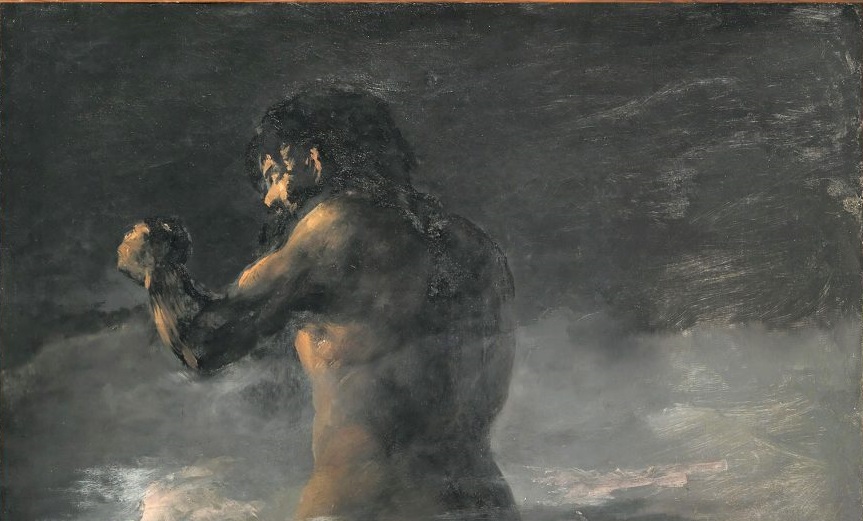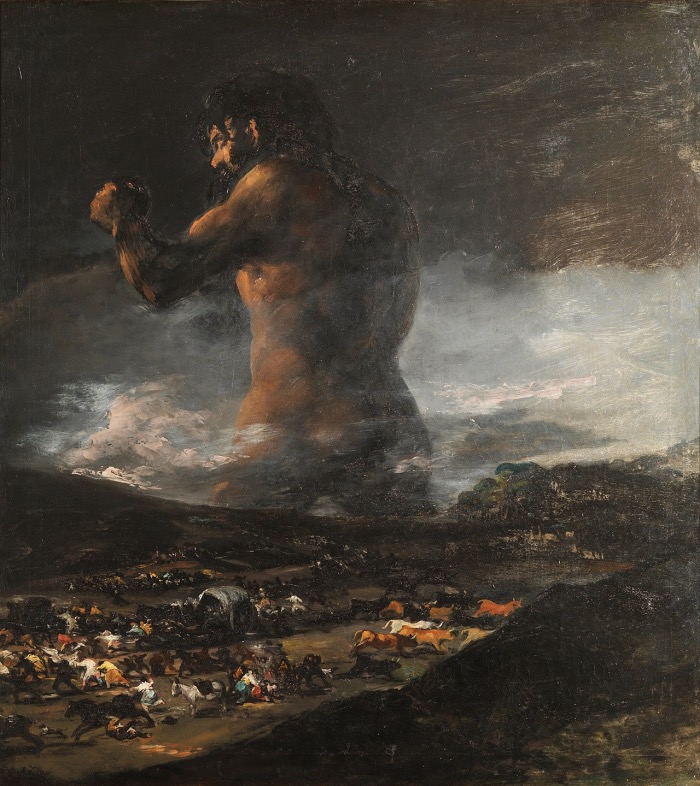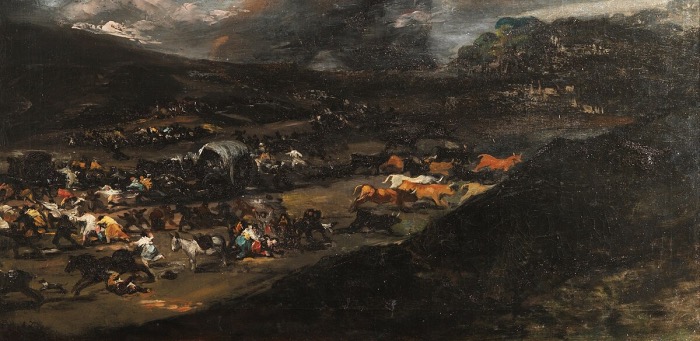
Have you ever tried to understand the mysteries surrounding the enigmatic work known as Goya’s Colossus? This majestic work, imbued with history and mystery, has continued to enchant and question art experts for centuries.
In the sphere of Spanish art, Francisco Goya holds a prominent place because of his unique ability to capture the human essence and turmoil of his era. Goya’s Colossus is no exception, as this painting defies time with its powerful composition and two different interpretations.
Goya’s Colossus: analysis and trivia

Il Colosso di Goya
Despite the lack of certainty regarding the exact date of its creation, scholars date the creation of Goya’s Colossus to the early days of the Spanish War of Independence, a difficult and dark period whose influence is reflected in the work.
The hypothesis that the work was painted in about 1808 is supported by the fact that the painting is mentioned among Goya’s possessions in the inventory compiled after his wife’s death in 1812, thus offering a key chronological reference.
ANALYSIS OF GOYA’S COLOSSUS
Analysis of Goya’s painting requires meticulous observation that goes beyond the first impression elicited by the dominant figure of the giant.
The work is a masterpiece of contrasts, not only visual but also thematic. Indeed, the canvas is dominated by the dark and blurred figure of the Colossus, while the human figures, almost lost in the lower part of the painting, are painted with rapid strokes, conveying a sense of desperation and urgency to leave those lands.
Technically, Goya makes masterful use of chiaroscuro, accentuating the drama of the scene. Shadows envelop the giant, while the light is more like a glow and seems unnatural. The landscape itself, with its empty vastness and dark hues, contributes to the tense atmosphere, making the ground not just a backdrop but an emotional participant in the work.
On a symbolic level, Goya’s Colossus can be interpreted as a representation of the struggle between oppressive powers and human resilience. While the giant might represent a tyrannical government or the overbearing forces of war, the small human figures symbolize the fragility but also the persistent resilience of the human spirit. Also interesting is the ambiguity of the Colossus: its posture can be seen as threatening or protective, a detail that invites viewers to reflect on the changing nature of power and the human perception of what is external and imposing.
ENIGMAS AND INTERPRETATIONS OF GOYA’S COLOSSUS
One of the most fascinating features of this work is its enigmatic nature.
What is striking is the image of a multitude that seems to flee in terror in the half-light, as if threatened by a dark and overwhelming force. The nature of this force, however, remains a mystery.
It is unclear whether the giant walking on the horizon and with his fist raised in a gesture that may seem threatening, is the source of terror or merely a witness to chaotic events.
There are many interpretations.
Some believe that the giant embodies absolutist power or perhaps war itself, representing the violent struggle against the French.
Interestingly, however, a poem by J. B. Arriaza from 1808 (the same year as Goya’s Colossus creations) recounts the appearance of a giant, interpreted as a divine protector of Spain, opposing Napoleonic forces.
In an evocative parallel, the giant in Goya’s painting does not seem to stalk the anxious crowd, but rather moves in the opposite direction, perhaps suggesting a defensive rather than an aggressive role.
CURIOSITY
Over the years, Goya’s Colossus has attracted not only admiration but also a number of anecdotes and curiosities that further contribute to its enigmatic appeal. One of the most intriguing questions concerns the authenticity of the work itself.
In 2008, a heated debate rocked the art world when experts at the Prado Museum, where the painting is kept, questioned Goya’s authorship of the execution of “Colossus,” attributing it instead to one of his lesser-known contemporaries, Asensio Juliá.
This hypothesis has stimulated new discussions and studies, showing how the work continues to stimulate investigation and controversy more than two centuries after its creation.
Another curiosity concerns the figure of the giant himself.
While many giants in mythology and classical art are depicted with clear and distinctive details, Goya’s Colossus is distinguished by its lack of defined features and ambiguous position in the landscape. This artistic choice has fueled numerous interpretations, some of which suggest that the giant represents a universal symbol of threat or protection, rather than a character with its own narrative identity.
Moreover, it is fascinating to note that despite its somber tone and seemingly tragic subject matter, the painting has been a source of inspiration for several modern artistic manifestations, including literature, film, and even comic books, confirming the ability of Goya’s art to influence and permeate culture beyond the boundaries of its original time and space.

Goya’s Colossus remains a work that invites interpretation and discussion. Between symbolism and historical reality, it reminds us of Goya’s genius and his ability to transcend time, offering a profound look at human horrors and hopes.
Its ambiguity only adds to its appeal, inviting us to explore not only art but also history and human essence.

